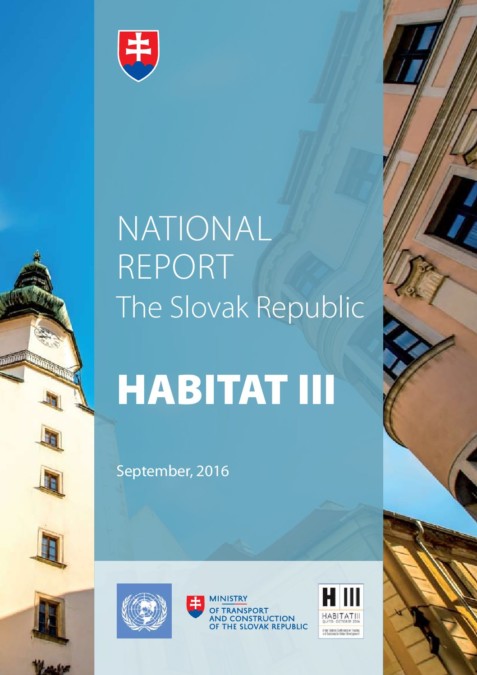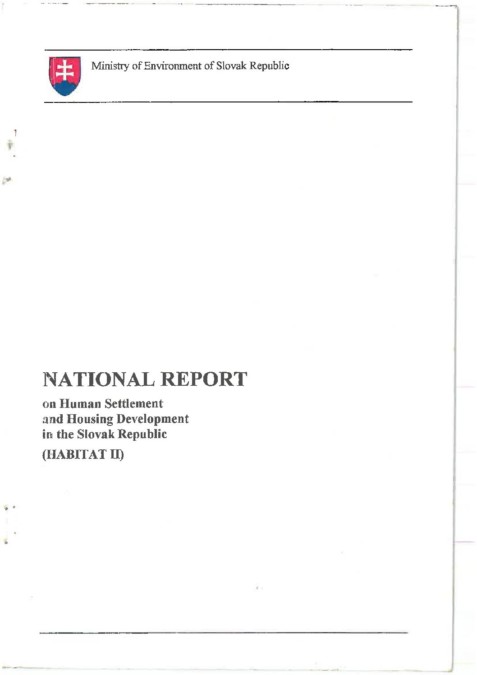
Slovakia
Urban indicators:
| Value | Year | ||
| Surface area (sq km) | 49035 | 2014 | Excluding inland water. |
| Population (proj., 000) | 5429 | 2016 | |
| Pop. density (per sq km) | 112.9 | 2016 | |
| Capital city | Bratislava | 2015 | |
| Capital city pop. (000) | 401 | 2015 | |
| Population growth rate (average annual %) | 0.1 | 2010-2015 | |
| Urban population growth rate (average annual %) | -0.3 | 2010-2015 | |
| CO2 emission estimates (000 tons/tons per capita) | 33678/6.2 | 2013 | |
| Population using improved drinking water sources (urban/rural, %) | 100.0/100.0 | 2015 | |
| Population using improved sanitation facilities (urban/rural, %) | 99.4/98.2 | 2015 |
| 1995 | 2005 | 2014/2015 | |
| Urban population ('000) | 3,032 | 2,996 | 2,925 |
| Level of urbanization (%) | 56.5 | 55.6 | 53.6 |
National Report:
National Report Executive Summary:
The Slovak Republic uses this occasion to make a contribution
to the conference Habitat III, during which it
will hold the presidency of the Council of EU, as well as to
evaluate the development of Slovak cities since the
previous world conference Habitat II held in Istanbul in
1996. The report also offers the opportunity to describe
the role played by Slovak cities in the overall socioeconomic
development of the country. Slovakia is a small
country and it may seem to have nothing to contribute
to the worldwide discussion on urban agenda. However,
there are many reasons why the position of Slovak cities
should be compared with other countries of the world.
Perhaps the most important reason is that cities, no
matter what country they are in or however small, are
and will always be drivers of the economy and social
development. They represent territories with the highest
concentration of activities, both positive (economy,
innovation, financial and human capital) and negative
(pollution, crime, transport problems, individualism and
pathogenic social phenomena). Answering the global
questions asked during the preparation of the conference
Habitat III allows us not only to understand the position
of our cities in a broader international context, but also to
examine how globally adopted postulates and solutions
are adaptable and applicable to our internal policies and
procedures. Moreover, Slovakia has much to offer to the
world, because over the last 20 years it has undergone an
extremely fast political and economic transformation and
knows its impact very well.
The development of the settlement of the Slovak Republic
with regard to the urban development in the last decades
cannot be described in individual chapters separately,
because most processes of political, demographic,
social and economic development and their effects on
the environment and quality of life of population are
closely related to each other. For example, the effects
of the reform of public administration are referred to in
several chapters. This has been running continuously
since the change of the political regime in the country in
1989, but it achieved the highest scope and had decisive
importance for the strengthening of the self-government
of the society and thus for urban management and
governance in the period of 2002 - 2005.
Although the whole national report should be preferably
devoted to the cities, in several chapters, it was impossible to objectively describe the specific situation of the
cities due to the lack of relevant statistical information.
This limitation results from the fact that censuses with
a ten-year periodicity have not resulted into datasets
with rural-urban classification. Sample statistical surveys
are implemented on a nationwide sample. Consequently,
the report refers to general empiric observations,
where necessary.
The content of the report fulfils the requirement of UNHabitat,
though some subchapters are regrouped to other
chapters, where their interconnection is more obvious in
the conditions of Slovakia.
The Slovak Republic spreads over an area of 49,035 km².
It borders with the Czech Republic, Austria, Hungary,
Ukraine and Poland. Its population is approximately
5.41 million and its biggest and capital city is Bratislava
with a population of 423,0001. Besides the capital city,
7 regional cities with a population of 56,000 to 240,000
fulfil the function of administrative centres of regional
self-government.
The Slovak Republic is a parliamentary democracy. The
national language is Slovak. Following an integration
process which took many years accompanied by numerous
economic and political changes, the Slovak Republic
became an EU Member State in 2004 and a member of
NATO in 2004. It has been part of the Schengen Area since
2007 and of the eurozone since 2009.
Statistics:
Basic services and infrastructure
Urban population with access to safe drinking water (%)
Urban population with access to adequate sanitation (%)
Urban population with access to regular waste collection (%)
Urban population with access to clean domestic energy (%)
Urban population with access to public transport (%)
Indicators for urban policies, legislation and economy
Local authorities having implemented plans and designs that are inclusive and respond to urban population growth adequately (%)
Statements by Slovakia:
-
Habitat III Plenaries
We thank Slovakia for their generous contribution to the Habitat III Trust Fund and for acting as a member of the Bureau of the Preparatory Process.


